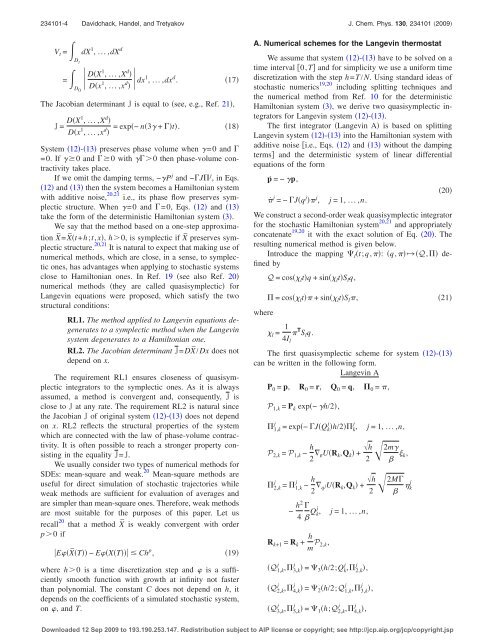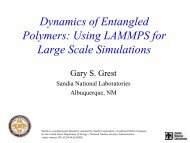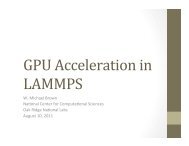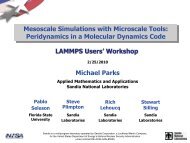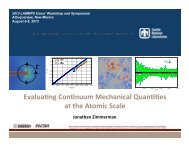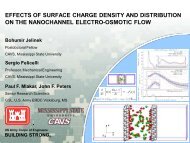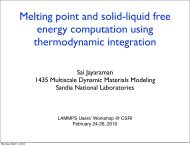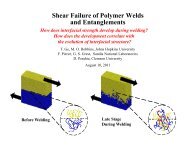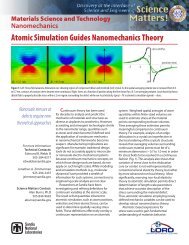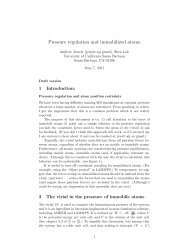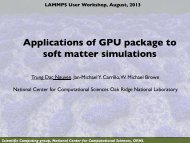Langevin thermostat for rigid body dynamics - Lammps
Langevin thermostat for rigid body dynamics - Lammps
Langevin thermostat for rigid body dynamics - Lammps
Create successful ePaper yourself
Turn your PDF publications into a flip-book with our unique Google optimized e-Paper software.
234101-4 Davidchack, Handel, and Tretyakov J. Chem. Phys. 130, 234101 2009<br />
V t =D t<br />
dX 1 , ...,dX d<br />
=D 0 DX1 , ...,X d <br />
Dx 1 , ...,x d dx 1 , ...,dx d .<br />
17<br />
The Jacobian determinant J is equal to see, e.g., Ref. 21,<br />
J = DX1 , ...,X d <br />
Dx 1 , ...,x d <br />
= exp− n3 + t.<br />
18<br />
System 12-13 preserves phase volume when =0 and <br />
=0. If 0 and 0 with 0 then phase-volume contractivity<br />
takes place.<br />
If we omit the damping terms, −P j and −J j , in Eqs.<br />
12 and 13 then the system becomes a Hamiltonian system<br />
with additive noise, 20,21 i.e., its phase flow preserves symplectic<br />
structure. When =0 and =0, Eqs. 12 and 13<br />
take the <strong>for</strong>m of the deterministic Hamiltonian system 3.<br />
We say that the method based on a one-step approximation<br />
X¯ =X¯ t+h;t,x, h0, is symplectic if X¯ preserves symplectic<br />
structure. 20,21 It is natural to expect that making use of<br />
numerical methods, which are close, in a sense, to symplectic<br />
ones, has advantages when applying to stochastic systems<br />
close to Hamiltonian ones. In Ref. 19 see also Ref. 20<br />
numerical methods they are called quasisymplectic <strong>for</strong><br />
<strong>Langevin</strong> equations were proposed, which satisfy the two<br />
structural conditions:<br />
RL1. The method applied to <strong>Langevin</strong> equations degenerates<br />
to a symplectic method when the <strong>Langevin</strong><br />
system degenerates to a Hamiltonian one.<br />
RL2. The Jacobian determinant J=DX¯ /Dx does not<br />
depend on x.<br />
The requirement RL1 ensures closeness of quasisymplectic<br />
integrators to the symplectic ones. As it is always<br />
assumed, a method is convergent and, consequently, J is<br />
close to J at any rate. The requirement RL2 is natural since<br />
the Jacobian J of original system 12-13 does not depend<br />
on x. RL2 reflects the structural properties of the system<br />
which are connected with the law of phase-volume contractivity.<br />
It is often possible to reach a stronger property consisting<br />
in the equality J=J.<br />
We usually consider two types of numerical methods <strong>for</strong><br />
SDEs: mean-square and weak. 20 Mean-square methods are<br />
useful <strong>for</strong> direct simulation of stochastic trajectories while<br />
weak methods are sufficient <strong>for</strong> evaluation of averages and<br />
are simpler than mean-square ones. There<strong>for</strong>e, weak methods<br />
are most suitable <strong>for</strong> the purposes of this paper. Let us<br />
recall 20 that a method X¯ is weakly convergent with order<br />
p0 if<br />
EX¯ T − EXT Ch p ,<br />
19<br />
where h0 is a time discretization step and is a sufficiently<br />
smooth function with growth at infinity not faster<br />
than polynomial. The constant C does not depend on h, it<br />
depends on the coefficients of a simulated stochastic system,<br />
on , and T.<br />
A. Numerical schemes <strong>for</strong> the <strong>Langevin</strong> <strong>thermostat</strong><br />
We assume that system 12-13 have to be solved on a<br />
time interval 0,T and <strong>for</strong> simplicity we use a uni<strong>for</strong>m time<br />
discretization with the step h=T/N. Using standard ideas of<br />
stochastic numerics 19,20 including splitting techniques and<br />
the numerical method from Ref. 10 <strong>for</strong> the deterministic<br />
Hamiltonian system 3, we derive two quasisymplectic integrators<br />
<strong>for</strong> <strong>Langevin</strong> system 12-13.<br />
The first integrator <strong>Langevin</strong> A is based on splitting<br />
<strong>Langevin</strong> system 12-13 into the Hamiltonian system with<br />
additive noise i.e., Eqs. 12 and 13 without the damping<br />
terms and the deterministic system of linear differential<br />
equations of the <strong>for</strong>m<br />
ṗ =−p,<br />
20<br />
˙ j =−Jq j j , j =1, ...,n.<br />
We construct a second-order weak quasisymplectic integrator<br />
<strong>for</strong> the stochastic Hamiltonian system 20,21 and appropriately<br />
concatenate 19,20 it with the exact solution of Eq. 20. The<br />
resulting numerical method is given below.<br />
Introduce the mapping l t;q,: q,Q, defined<br />
by<br />
Q = cos l tq + sin l tS l q,<br />
where<br />
= cos l t + sin l tS l ,<br />
21<br />
l = 1 T S l q.<br />
4I l<br />
The first quasisymplectic scheme <strong>for</strong> system 12-13<br />
can be written in the following <strong>for</strong>m.<br />
<strong>Langevin</strong> A<br />
P 0 = p, R 0 = r, Q 0 = q, 0 = ,<br />
P 1,k = P k exp− h/2,<br />
j<br />
1,k = exp− JQ j k h/2 j k , j =1, ...,n,<br />
P 2,k = P 1,k − h 2 rUR k ,Q k + h<br />
2 2m k,<br />
j<br />
2,k<br />
j<br />
= 1,k − h 2 q jUR h<br />
k,Q k +<br />
− h2 <br />
4 Q k j ,<br />
R k+1 = R k + h m P 2,k,<br />
j<br />
Q 1,k<br />
j<br />
Q 2,k<br />
j<br />
Q 3,k<br />
j<br />
, 3,k<br />
j<br />
, 4,k<br />
j<br />
, 5,k<br />
j =1, ...,n,<br />
= 3 h/2;Q j k , 2,k ,<br />
= 2 h/2;Q 1,k<br />
= 1 h;Q 2,k<br />
j<br />
j<br />
j<br />
j<br />
, 3,k<br />
j<br />
, 4,k<br />
,<br />
2 2M <br />
,<br />
k j<br />
Downloaded 12 Sep 2009 to 193.190.253.147. Redistribution subject to AIP license or copyright; see http://jcp.aip.org/jcp/copyright.jsp


